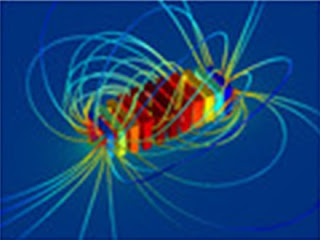
Last Friday (October 10th ) I had the pleasure of attending the COMSOL Conference 2008 Boston at the Renaissance Boston Waterfront Hotel. This venue is very close to the Boston Convention and Exhibition Center (BCEC) where MTT-S IMS 2009 will be held, so it gave me an opportunity to preview this up and coming section of Boston down by the waterfront while catching up with the engineers and scientists using this advanced software.
Comsol puts on a very impressive workshop each year with a crowd of engineers, physicists, chemists, students and scientists numbering in the hundreds. With Multiphysics software, cross-over disciplines are a guarantee. Before joining the press luncheon/briefing, I sat down with several attendees enjoying their company provided lunch and we talked about their impressions of this two day event. I spoke with scientists in earth sciences, biophysics, aeronautics, and microwave design. The presentations are of the highest technical caliber and represent substantial research. Some of these talks included:
· Capacitance Computation of Multilayered and Multiconductor Interconnects Using Finite Element Method
· Modeling Carbon Nanotube FET Physics
· Gate Control of Single-Electron Spins in GaAs/AlGaAs Semiconductor Quantum DotCoupled Electromagnetics- Multiphase Porous Media Model for Microwave Combination Heating
It was enlightening to share perspectives on a wide-range of engineering challenges outside of our field. Exposure to different disciplines is among the best ways to broaden your arsenal for creatively solving an engineering problem. I encourage our readers to do so anytime the opportunity arises. The nature of Comsol’s Multiphysics software also provides a lot of common ground between the RF component designer and the engineer working on problems like -structural mechanics of cooling catheters. Our common ground is a need for a user-friendly CAD model interface; adaptive, fast and accurate meshing; and state-of-the-art visualization and report generation. At the press luncheon, I learned how Comsol has been addressing these needs.
Multiphysics® 3.5 has expanded the software’s interoperability with third-party CAD/CAM/CAE applications, providing new Parasolid® file format support and a new bidirectional Autodesk Inventor® interface. Parasolid improves file import efficiency by eliminating the conversion of objects to COMSOL geometry. It enhances productivity by giving users the ability to repair or defeature individual parts in an assembly easily and quickly. Parasolid support saves substantial time when meshing by enabling you to mesh on the Parasolid geometry directly. Additionally, the CAD Import Module is now also available on the Macintosh.
Like its SolidWorks® counterpart, Autodesk Inventor maintains two-way associativity between Inventor and COMSOL so that any changes made in a COMSOL or Autodesk Inventor session propagate across both solutions automatically. The Inventor and SolidWorks bidirectional interfaces, when used with the CAD Import Module, now support geometric parametric sweeps to automatically compute solutions for different geometric shapes. This new functionality lets the engineer wrap any parametric sweeps around any solver, including time-dependent, stationary, or eigenvalue solvers. Parametric sweeps can be run on distributed-memory systems such as Linux and Windows Compute clusters.
Version 3.5 also offers new solvers, coding, and usability enhancements, as well as a many new functionalities, application modes, and material models and properties in COMSOL’s suite of discipline-specific modules boost efficiency and productivity. Solving is substantially faster for time-dependent structural mechanics, electromagnetic, acoustics, and fluid-flow simulations using a new solver, cutting memory usage by as much as 50 percent for common dynamic multiphysics simulations, such as Joule heating, with the new time-dependent segregated solver. This solver also offers new flexible settings that make setting up problems with various multiphysics couplings easier and faster. As electronics shrink in size and grow more complex, designers will need to consider thermal and mechanical considerations ion addition to electrical performance. This is the realm of Multiphysics simulation.
Specific to the Microwave field, Multiphysics® 3.5 offers two specialized modules, which also offers new capability in this latest release. The RF Module 3.5 introduces new circuit ports for simulating the connection of a transmission line or an antenna and an external circuit. Adaptive meshing gives a higher accuracy of extracted S-parameters, which can be used for accurate system modeling. ECAD import shortens the path from circuit board layout to 3D geometry. Time domain simulations are up to 4 times faster using the new time-dependent solver.
For performing thermal analysis, the Heat Transfer Module 3.5 greatly speeds up non-isothermal flow and convective heat transfer simulations as well as provides better stabilization for modeling free convection and heat transfer in turbulent flows. Simulations of heat and flow in electronic cooling, free convection, and general thermal management applications are now up to 8 times faster, while memory requirements for thermal stresses are down 25 percent. In heat conduction applications, new functionality runs simulations of unbounded domains through the infinite elements technique.
MEMS have shown great promise as a technology that can be used for microwave applications. So the MEMS module is of potential interest to our field. The MEMS Module 3.5 features new two-phase flow application modes tuned for multiphysics couplings, which are enhanced with new surface tension data from the Liquids and Gases material properties library. Electro-thermomechanical simulations are now easy to set up with the new predefined multiphysics coupling. Piezo-electric devices and MEMS in general can be integrated in SPICE circuit simulations. You can also include structural damping, dielectric, and coupling losses in the enhanced piezoelectric simulation environment. Viscoelastic material models and large deformations are also incorporated into this release. The new ECAD import greatly facilitates the generation of 3D geometries from mask layouts.


